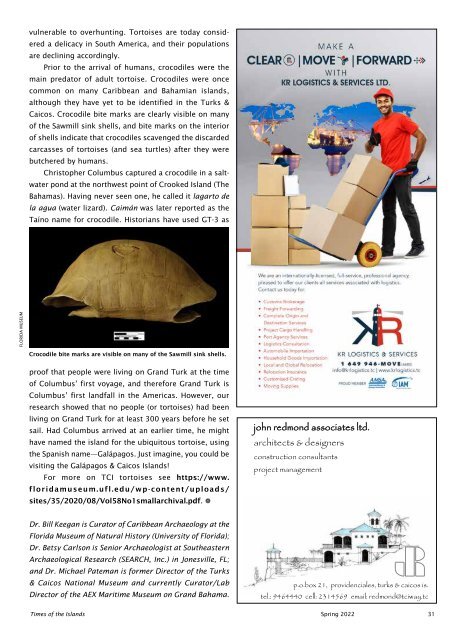Times of the Islands Spring 2022
Presents the "soul of the Turks & Caicos Islands" with in-depth features about local people, culture, history, environment, real estate, businesses, resorts, restaurants and activities.
Presents the "soul of the Turks & Caicos Islands" with in-depth features about local people, culture, history, environment, real estate, businesses, resorts, restaurants and activities.
You also want an ePaper? Increase the reach of your titles
YUMPU automatically turns print PDFs into web optimized ePapers that Google loves.
vulnerable to overhunting. Tortoises are today considered<br />
a delicacy in South America, and <strong>the</strong>ir populations<br />
are declining accordingly.<br />
Prior to <strong>the</strong> arrival <strong>of</strong> humans, crocodiles were <strong>the</strong><br />
main predator <strong>of</strong> adult tortoise. Crocodiles were once<br />
common on many Caribbean and Bahamian islands,<br />
although <strong>the</strong>y have yet to be identified in <strong>the</strong> Turks &<br />
Caicos. Crocodile bite marks are clearly visible on many<br />
<strong>of</strong> <strong>the</strong> Sawmill sink shells, and bite marks on <strong>the</strong> interior<br />
<strong>of</strong> shells indicate that crocodiles scavenged <strong>the</strong> discarded<br />
carcasses <strong>of</strong> tortoises (and sea turtles) after <strong>the</strong>y were<br />
butchered by humans.<br />
Christopher Columbus captured a crocodile in a saltwater<br />
pond at <strong>the</strong> northwest point <strong>of</strong> Crooked Island (The<br />
Bahamas). Having never seen one, he called it lagarto de<br />
la agua (water lizard). Caimán was later reported as <strong>the</strong><br />
Taíno name for crocodile. Historians have used GT-3 as<br />
FLORIDA MUSEUM<br />
Crocodile bite marks are visible on many <strong>of</strong> <strong>the</strong> Sawmill sink shells.<br />
pro<strong>of</strong> that people were living on Grand Turk at <strong>the</strong> time<br />
<strong>of</strong> Columbus’ first voyage, and <strong>the</strong>refore Grand Turk is<br />
Columbus’ first landfall in <strong>the</strong> Americas. However, our<br />
research showed that no people (or tortoises) had been<br />
living on Grand Turk for at least 300 years before he set<br />
sail. Had Columbus arrived at an earlier time, he might<br />
have named <strong>the</strong> island for <strong>the</strong> ubiquitous tortoise, using<br />
<strong>the</strong> Spanish name—Galápagos. Just imagine, you could be<br />
visiting <strong>the</strong> Galápagos & Caicos <strong>Islands</strong>!<br />
For more on TCI tortoises see https://www.<br />
floridamuseum.ufl.edu/wp-content/uploads/<br />
sites/35/2020/08/Vol58No1smallarchival.pdf. a<br />
john redmond associates ltd.<br />
architects & designers<br />
construction consultants<br />
project management<br />
Dr. Bill Keegan is Curator <strong>of</strong> Caribbean Archaeology at <strong>the</strong><br />
Florida Museum <strong>of</strong> Natural History (University <strong>of</strong> Florida);<br />
Dr. Betsy Carlson is Senior Archaeologist at Sou<strong>the</strong>astern<br />
Archaeological Research (SEARCH, Inc.) in Jonesville, FL;<br />
and Dr. Michael Pateman is former Director <strong>of</strong> <strong>the</strong> Turks<br />
& Caicos National Museum and currently Curator/Lab<br />
Director <strong>of</strong> <strong>the</strong> AEX Maritime Museum on Grand Bahama.<br />
p.o.box 21, providenciales, turks & caicos is.<br />
tel.: 9464440 cell: 2314569 email: redmond@tciway.tc<br />
<strong>Times</strong> <strong>of</strong> <strong>the</strong> <strong>Islands</strong> <strong>Spring</strong> <strong>2022</strong> 31
















